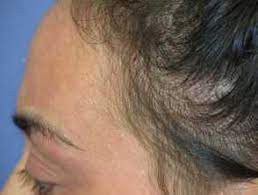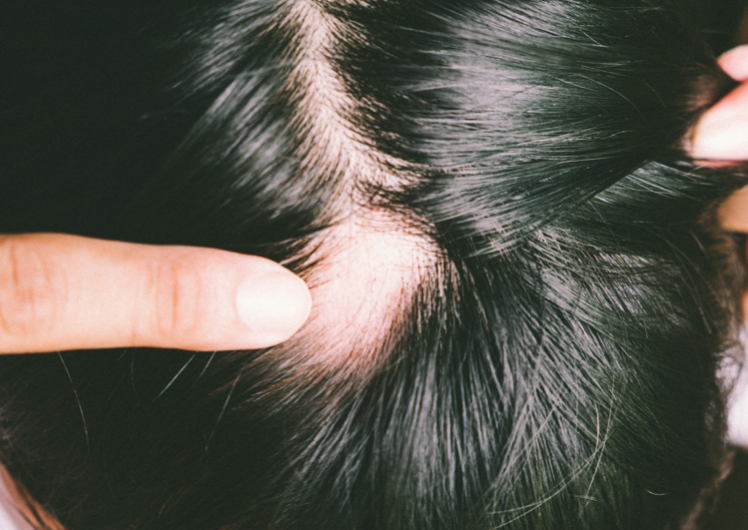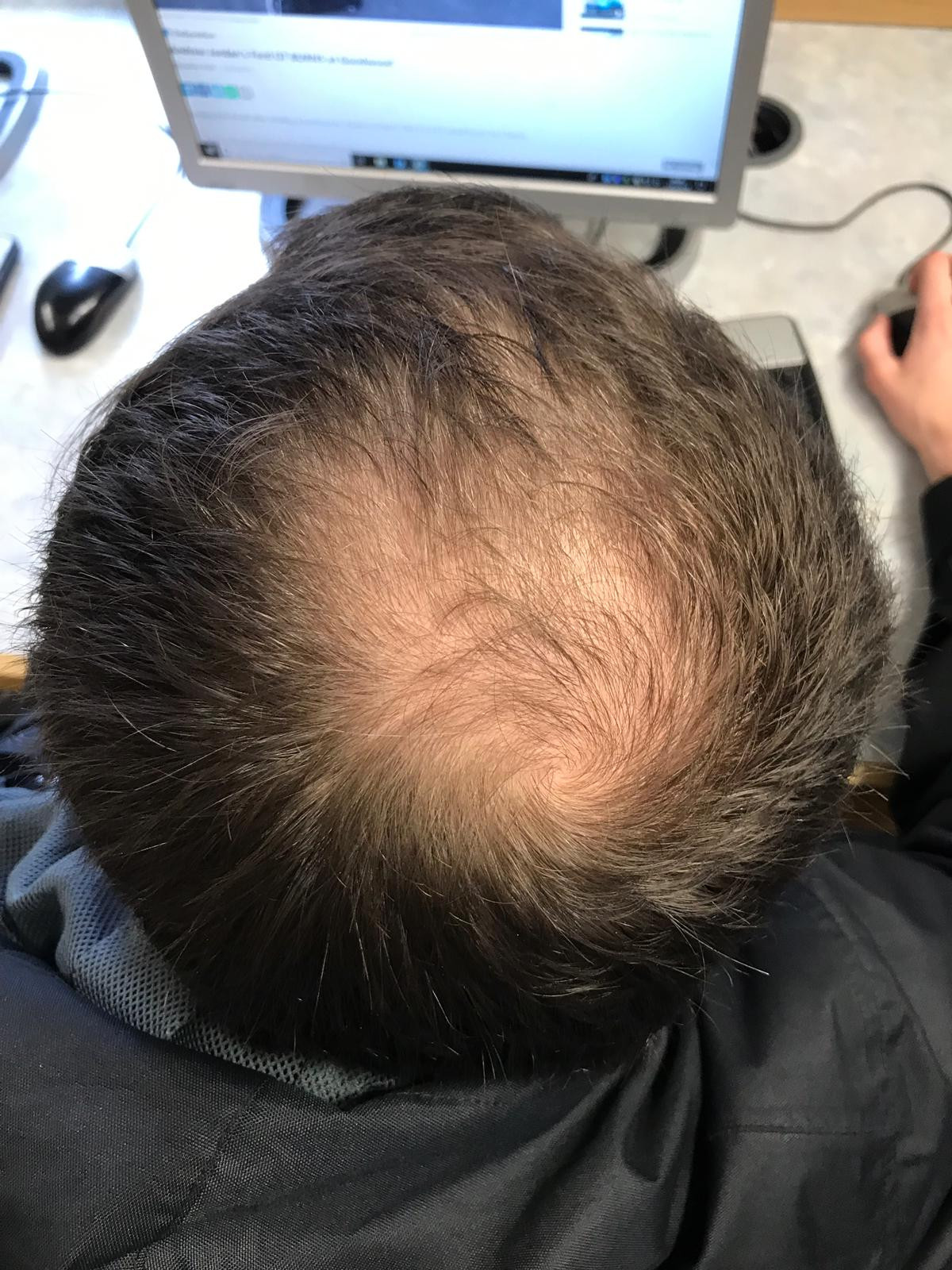Definisi
Alopesia adalah rambut rontok, terlepas dari penyebabnya. Kerontokan rambut ini tidak terbatas pada kulit kepala, namun dapat terjadi pada bagian tubuh manapun yang memiliki rambut. Alopesia dibagi menjadi dua kategori utama, yaitu akibat scar (bekas luka) dan non-scarring. Alopesia yang lebih sering terjadi adalah alopesia non-scarring.
Penyebab
Rambut memiliki tiga fase dalam siklus kehidupannya, yaitu anagen, katagen, dan telogen. Anagen merupakan fase pertumbuhan rambut, katagen merupakan fase istirahat rambut, dan telogen merupakan fase perontokan rambut. Sekitar 90% dari semua rambut berada di dalam fase anagen dan katagen.
Alopesia memiliki penyebab yang berbeda tergantung jenisnya. Alopesia non-scarring terbagi atas enam kategori, yaitu:
- Alopesia areata. Kerontokan rambut jenis ini dapat terjadi pada seluruh bagian tubuh, misalnya pada kulit kepala, wajah, badan, lengan, ataupun tungkai. Kerontokan yang terjadi hanya pada satu area tubuh disebut sebagai alopesia areata. Kerontokan yang terjadi pada satu anggota tubuh secara keseluruhan disebut sebagai alopesia totalis, sementara kerontokan yang terjadi pada seluruh tubuh disebut sebagai alopesia universalis. Penyebab pastinya belum diketahui, namun diduga akibat penyakit autoimun. Penyakit autoimun merupakan penyakit yang disebabkan oleh kesalahan sel kekebalan tubuh dalam mengenali sel tubuh sebagai benda asing
- Alopesia androgenetik. Kerontokan rambut jenis ini dipengaruhi oleh gen dan hormon androgen
- Telogen efluvium. Kerontokan rambut jenis ini menyebabkan perpindahan fase siklus rambut dari anagen ke telogen secara langsung. Telogen efluvium dapat disebabkan oleh penyakit seperti hipertiroidisme (kadar hormon tiroid yang meningkat), stres misalnya terkait pembedahan, obat-obatan tertentu, kurang makan, dan sebagainya
- Alopesia traumatik. Alopesia jenis ini disebabkan oleh penarikan rambut yang sangat kencang, dan terutama terlihat pada anak-anak. Alopesia ini dapat disebabkan oleh trikotilomania, atau kebiasaan seseorang untuk menarik rambutnya berulang kali
- Tinea kapitis. Penyakit ini merupakan infeksi jamur yang terjadi pada rambut kepala. Tinea kapitis tipe black dot dapat menyebabkan alopesia non-scarring
- Anagen efluvium. Kerontokan rambut jenis ini terjadi pada fase anagen, yang tampak pada penderita kanker yang sedang menjalani kemoterapi
Sementara itu, alopesia scarring terbagi atas tiga kategori utama:
- Tinea kapitis. Tinea kapitis dapat disertai dengan peradangan yang dapat meninggalkan bekas luka
- Alopesia musinosa. Hal ini terjadi ketika zat musinosa terkumpul di folikel rambut dan kelenjar minyak. Zat ini meningkatkan peradangan dan dapat menghalangi tumbuhnya rambut
- Alopesia neoplastika. Kerontokan rambut jenis ini melibatkan sel-sel ganas yang menyerang rambut pada kulit kepala.
Faktor Risiko
Faktor risiko alopesia tergantung dari jenisnya. Alopesia areata dapat terjadi pada semua usia, ras, dan jenis kelamin, tanpa kecenderungan tertentu. Sementara itu, alopesia androgenetik menyerang 50% pria dan 15% wanita, terutama wanita yang sudah tidak haid (menopause). Kondisi ini juga lebih banyak menyerang ras kulit putih dibandingkan kulit berwarna. Pada telogen efluvium, wanita lebih sering terdampak daripada pria. Tinea kapitis paling sering terjadi pada anak-anak berkulit gelap. Anagen efluvium merupakan hal yang lazim terjadi pada penderita kanker yang mendapatkan kemoterapi.
Gejala
Kejadian alopesia berbeda-beda tergantung jenisnya, oleh karena itu, riwayat lengkap sangat diperlukan untuk menentukan diagnosis. Alopesia areata pada umumnya tidak disertai gejala apapun, namun sebagian pasien mengeluhkan sensasi terbakar atau gatal pada daerah yang terkena. Alopesia areata muncul secara tiba-tiba dan tidak terduga. Kerontokan ini dapat terjadi hanya dalam semalam.
Alopesia androgenetik muncul secara bertahap. Biasanya, pasien mengeluhkan penipisan rambut yang pertama kali terjadi pada daerah samping dan depan kepala, membentuk ulang garis rambut depan. Pada wanita, kebotakan lebih sering terjadi pada kepala daerah belakang atas (crown).
Alopesia tipe scarring dapat membentuk plak botak mirip alopesia areata. Namun, plak ini berbeda, karena ujung-ujungnya tampak lebih kasar. Daerah yang terkena juga dapat tampak mulus dan bersih, atau dapat berwarna kemerahan, bersisik, berubah warna, atau memiliki lenting yang berisi air atau nanah.
Diagnosis
Diagnosis alopesia ditegakkan berdasarkan riwayat dan pemeriksaan. Dokter dapat menanyakan runtutan kerontokan rambut pada Anda. Dokter juga dapat menanyakan kesehatan Anda secara umum, makan sehari-hari, kebiasaan, serta beberapa hasil pemeriksaan laboratorium. Kebiasaan yang terkait dengan alopesia adalah penggunaan sampo dan conditioner rambut. Dokter juga dapat menanyakan stres psikologis yang Anda alami, karena stres dapat menjadi penyebab rambut rontok. Riwayat keluarga juga dapat ditanyakan apabila ada kecurigaan terhadap pengaruh genetik, misalnya pada alopesia androgenetik.
Pemeriksaan dapat dilakukan pada kepala. Dokter dapat menarik rambut secara lembut pada beberapa bagian kepala untuk mengetahui penyebab kerontokan rambut. Jika ada kecurigaan terhadap infeksi jamur, dokter dapat menyinari bagian yang botak dengan lampu khusus (lampu Wood). Perbedaan warna pada bagian yang botak dapat menjadi petunjuk adanya jamur sebagai penyebab kebotakan.
Pemeriksaan laboratorium dapat dilakukan untuk mengetahui jenis dan penyebab alopesia. Pemeriksaan yang dapat dilakukan berupa pemeriksaan darah lengkap, pemeriksaan kadar besi dalam darah, fungsi hormon tiroid, antibodi terhadap sel tubuh, kadar hormon testosteron (hormon yang mengeluarkan sifat pria), hormon estrogen (yang mengeluarkan sifat wanita), serta hormon reproduksi lainnya. Untuk mengetahui jenis jamur, dokter dapat melakukan pemeriksaan dengan kerok kulit kepala yang kemudian dilihat di bawah mikroskop dengan bantuan zat KOH.
Pemeriksaan pencitraan yang dapat dilakukan dapat berupa rontgen dada dan magnetic resonance imaging (MRI) untuk mengetahui derajat alopesia musinosa. Dokter juga dapat melakukan pemeriksaan trikoskopi, yaitu pengamatan terhadap folikel rambut (tempat tumbuhnya rambut) menggunakan kaca pembesar.
Tata Laksana
Penanganan alopesia tergantung pada jenis dan penyebab alopesia. Pada alopesia androgenetik, terapi dapat menggunakan obat yang memperpanjang fase anagen pada rambut. Obat lainnya juga dapat berupa obat yang sering digunakan untuk pembesaran prostat jinak. Namun, obat ini hanya dapat digunakan pada pria, karena jika digunakan pada wanita, obat ini dapat membahayakan bagi janin.
Sementara itu, alopesia areata tidak selalu membutuhkan terapi. Namun, karena kondisi ini diduga terjadi akibat sel kekebalan tubuh yang menyerang sel-sel rambut, obat yang diberikan berfungsi untuk menekan respon sel kekebalan tubuh tersebut. Obat-obatan ini dapat disemprotkan atau dioleskan pada kulit kepala.
Apabila alopesia terjadi akibat jamur (tinea kapitis), antijamur akan diberikan untuk memberantas jamur.
Sementara itu, alopesia tipe scarring membutuhkan terapi yang lebih agresif karena dapat menyebabkan kebotakan permanen. Pengobatan dapat melibatkan berbagai macam obat, tergantung penyebab alopesia. Obat-obatan dapat berupa antiradang yang dioleskan pada kulit kepala, obat-obatan antimalaria, serta isotretinoin. Setelah kerontokan rambut berhenti, daerah yang mengalami kebotakan dapat diambil dengan pembedahan jika tidak terlalu besar. Pilihan lainnya adalah mencangkok folikel rambut dari daerah yang sehat.
Komplikasi
Orang yang memiliki kondisi alopesia dapat mengalami komplikasi psikososial dari kerontokan rambut seperti kecemasan dan depresi. Pada saat yang sama, orang dengan alopesia perlu menjalani berbagai pemeriksaan terhadap penyakit autoimun seperti penyakit Grave pada tiroid, vitiligo (perubahan sebagian warna kulit menjadi lebih terang), dan sebagainya.
Pencegahan
Pencegahan alopesia tergantung dari penyebabnya. Alopesia areata sangat sulit dicegah karena sifatnya yang muncul tiba-tiba. Namun, alopesia yang disebabkan oleh tinea kapitis dapat dicegah dengan cara berikut:
- Menghindari penggunaan sisir, pakaian, dan handuk bersamaan
- Rajin berkeramas
- Rajin mencuci tangan
- Menghindari hewan berbulu yang memiliki plak botak pada tubuhnya, atau mengobati hewan tersebut sebelum menyentuhnya (apabila merupakan hewan peliharaan)
Kapan Harus ke Dokter?
Jika Anda mengalami kebotakan secara tiba-tiba, Anda dapat berkonsultasi kepada dokter mengenai kondisi Anda. Alopesia memiliki sangat banyak kemungkinan penyebab, sehingga eksplorasi lebih lanjut perlu dilakukan untuk mengetahuinya. Alopesia, meskipun tampak tidak terlalu berbahaya, dapat menjadi penanda adanya penyakit autoimun yang lebih berat, sehingga sebaiknya diperiksakan.
Mau tahu informasi seputar penyakit lainnya, cek di sini ya!
- dr Anita Larasati Priyono
Aboud, A., & Zito, P. (2021). Alopecia. Retrieved 17 March 2022, from https://www.ncbi.nlm.nih.gov/books/NBK538178/
Bergen, T., & Cobb, C. (2019). Ringworm of the Scalp (Tinea Capitis): Causes, Symptoms, and Treatment. Retrieved 17 March 2022, from https://www.healthline.com/health/tinea-capitis
Bolduc, C. (2020). Alopecia Areata: Practice Essentials, Background, Pathophysiology. Retrieved 17 March 2022, from https://emedicine.medscape.com/article/1069931-overview
Feinstein, R. (2022). Androgenetic Alopecia: Practice Essentials, Background, Pathophysiology. Retrieved 17 March 2022, from https://emedicine.medscape.com/article/1070167-overview










